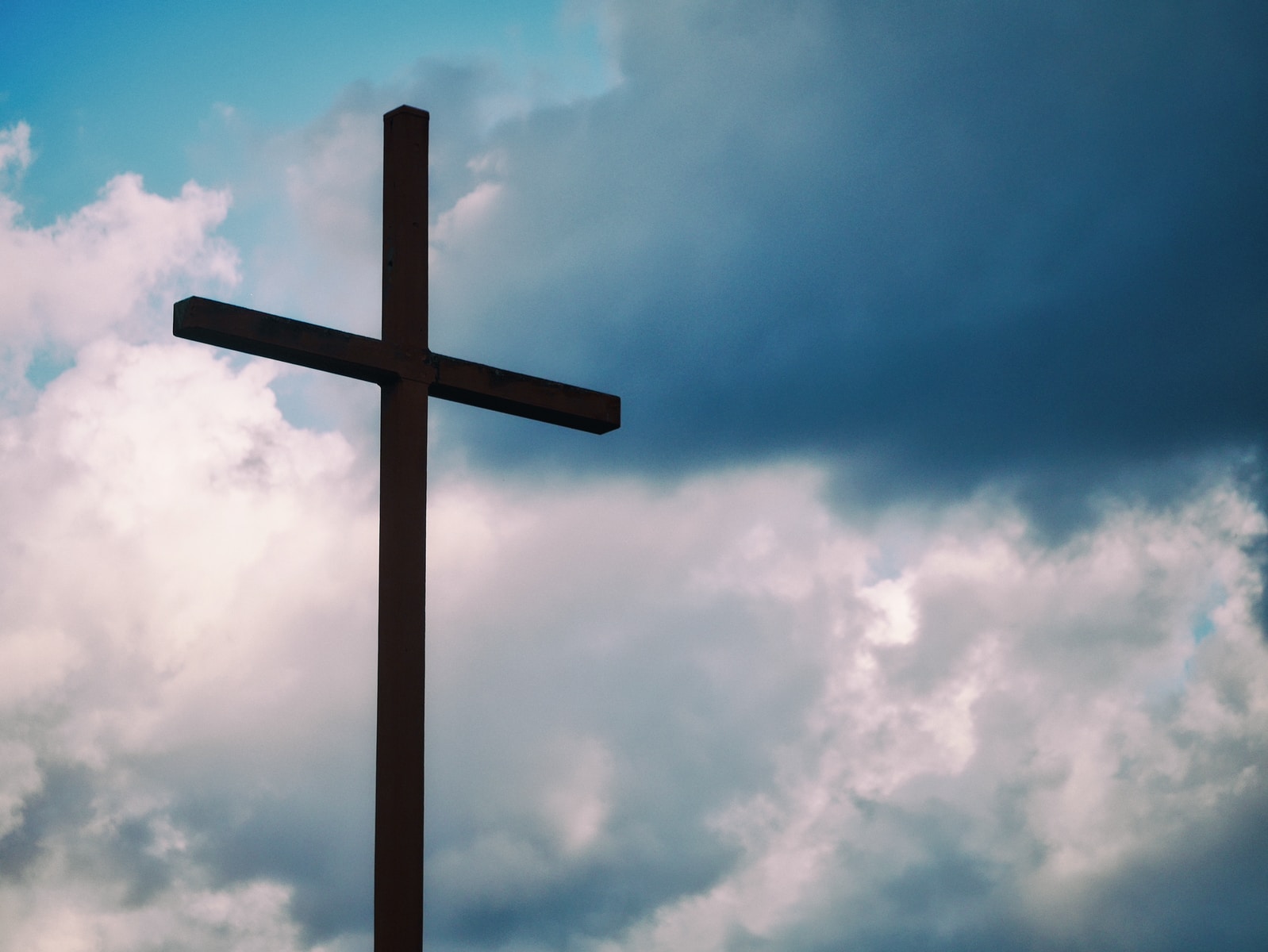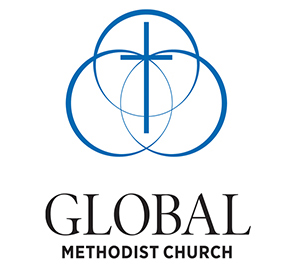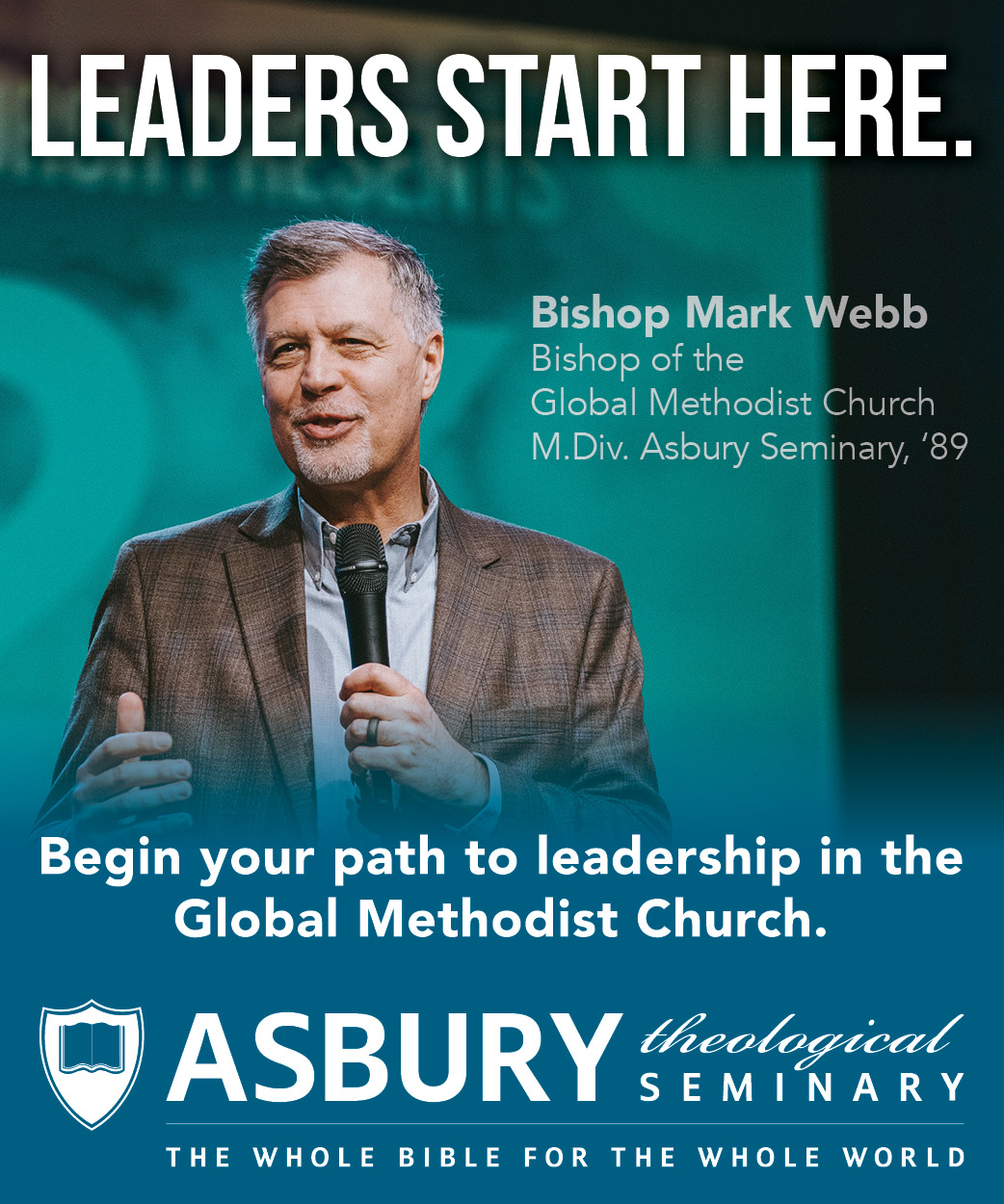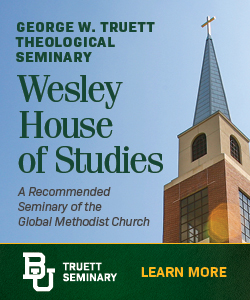 By Tom Lambrecht-
By Tom Lambrecht-
With apologies to Robert Frost, one of my favorite poets, he describes the current situation in The United Methodist Church in his poem, The Road Not Taken: “Two roads diverged in a yellow wood.” Two roads are diverging within United Methodism today, and we can see the impact of that divergence in the “sketches” offered by the Commission on a Way Forward and the Council of Bishops (COB) as described in a recent UM News Service article.
Sketch #1 is described by the COB as it “affirms the current Book of Discipline language and places a high value on accountability.” This approach is the most popular among evangelical and traditionalist United Methodists. It would require major efforts at accountability, including church trials and the “voting out” of bishops and annual conferences from United Methodism in order to be effective.
Sketch #2 is described by the COB as it “removes restrictive language and places a high value on contextualization. This sketch also specifically protects the rights of those whose conscience will not allow them to perform same gender weddings or ordain LGBTQ persons.” This model is the most popular among so-called “centrist” or moderate United Methodists. It would neither affirm nor prohibit same-sex marriage and the ordination of non-celibate LGBTQ persons. The decision would be left up to individual pastors and annual conferences. This plan has been floated before and did not find success at General Conference.
Sketch #3 is described by the COB as “grounded in a unified core that includes shared doctrine and services and one COB, while also creating different branches that have clearly defined values such as accountability, contextualization and justice.” This model would dispense with the current five geographical jurisdictions and replace them with three branches, each with a defining theology and moral stance. This option is the most complex and the most difficult to adopt, since it would require constitutional amendments.
It should be noted that the COB descriptions do not indicate how the central conferences outside the United States are accounted for in each of the models. It will be important that whatever proposal adopted by the General Conference considers fully and fairly its impact on the central conferences, so as not to harm them.
Divergent Theological Roads
These proposals suggest that there are two theological roads that are diverging in The United Methodist Church. One road believes that the practice of homosexuality is incompatible with Christian teaching, and that God is not glorified by this practice. Out of that theology flows the prohibition of same-sex marriage and the ordination of non-celibate LGBTQ persons. At a deeper level, this theology is based on an understanding of Scripture that gives the Bible primacy in determining what we believe and how we are to live. It values continuity with the historic Christian understanding of Scripture. Holders of this viewpoint are often called evangelicals, traditionalists, or orthodox.
A second road believes that God creates persons with a variety of sexual orientations and gender identities, and that God is glorified by persons who understand and live out of their authentic orientation and identity. Out of that theology flows the affirmation of same-sex marriage and the ordination of non-celibate LGBTQ persons. At a deeper level, this theology is based on an understanding of God’s revelation as continuing over time, based on but sometimes superseding the witness of Scripture. It values the incorporation of new insights and new understandings from science and philosophy that can reinterpret or even render obsolete the teachings of Scripture. Holders of this viewpoint are often called progressives.
These theological roads lead in different directions. They truly diverge. The models make room for that divergence with the “gracious exit” path that is provided with all three. Under Sketch #1, followers of the second theological road will need to depart from the UM Church, either willingly or unwillingly. Under Sketch #2, many followers of the first theological road will need to depart by reason of conscience. And the exit path is available to both groups under Sketch #3, if they find they cannot live with that model.
Strategic Roads
These proposals also suggest that there are two strategic roads that can be taken. A choice will need to be made between separation from and separation within. Both Sketches #1 and #2 envision the creation of a fairly univocal and united Methodism, from which those who cannot live with it will need to depart. In the case of Sketch #1, it is clear that progressives will need to depart and form their own separate church. Many progressives have said that they will not willingly depart. Their goal is not to form a separate denomination, but to change The United Methodist Church to an affirming view of LGBTQ practices. Progressives would need to be forced out, which would require years of accountability actions, trials, and discipline. It would have to overcome the reluctance of our current bishops to enforce the Discipline. This model would not end the fighting within our denomination and therefore would face a very difficult challenge in succeeding, even if adopted.
Sketch #2 is a bit more subtle. On the surface, it purports to create a space where each person can act according to his/her own conscience and beliefs. However, this model is inherently unstable. It is impossible for a church to hold two contradictory theological positions at the same time for long. Many evangelicals will choose to depart from the denomination because they cannot in good conscience be part of a church that permits practices that they believe go against Scripture. Many progressives will not rest until LGBTQ persons are fully affirmed everywhere in the denomination. They cannot long tolerate a situation where parts of the church are allowed to discriminate (in their view) against LGBTQ persons. So the pressure to affirm LGBTQ practices will continue, which pressure will in turn drive more evangelicals to depart from the denomination. The whole “centrist” approach appears to be a strategy to hold as much of the church together as possible while people either die or change their minds to embrace a progressive understanding.
Sketch #3 takes a different route. Rather than the separation from that will result from following models #1 or #2, Model #3 provides for separation within the denomination. A space would be created for each theological perspective–one that affirms LGBTQ practices and one that does not. A third space would allow such practices, but not require them. The individual spaces or branches would be the primary place where theology and ministry would be worked out and applied. Accountability would be maintained in each branch according to that branch’s understanding. Each branch would have to have the ability to determine its level of participation in any shared general agencies of the church. Each branch would have to have the ability to set its own standards and qualifications for clergy. Each branch would have to be able to elect its own bishops. And each branch would have to be financially self-supporting, such that funding is not going to support a branch that is in disagreement with the branch providing the funding. (Some have called this provision a “financial firewall.”)
For those thinking outside the box, this third model may hold the greatest potential for keeping the most people and congregations in The United Methodist Church. However, it is also the most difficult to adopt and implement. It would require numerous constitutional amendments, which takes a 2/3 vote at General Conference and a 2/3 vote of all annual conference members. There would need to be a several-year transition period of implementation, as annual conferences and congregations, as well as bishops and individual clergy, make their choices about which branch to affiliate with. If quick and easy are the requirements for a solution, then Sketch #2 is probably the best option. If one is looking at a way to keep the most people united, then Sketch #3 could fill the bill.
So there are forks in the road ahead: We will need to decide which theological road to follow. Will we affirm LGBTQ practices or not? And we will need to decide which strategic road to follow. Will we go for separation from or separation within? As in Frost’s poem, the road we choose, both individually and collectively, will make all the difference.
For further analysis of the three models in sketch form, I recommend blogs by David Watson and Joel Watts. Obviously, we need to have a lot more details about each of the options in order to fully understand and respond to them. Much more will need to be said about them, examining both the positives and the negatives of each. But we now have enough of an idea that we can begin to think about the possibilities inherent in each approach.
Thomas Lambrecht is a United Methodist clergyperson and vice president of Good News.






Sketch #1
I wish someone explains what the “graceful exit” means. Does it mean that churches will be able to leave and the trust clause suspended or does it refer to individuals leaving the denomination? Option number three only works if there is total separation between progressives and traditionalists. True traditionalist will not be linked in any way to a group they consider apostate. The day my denomination legalizes gay ordination or marriage is the day they throw me out.
There is a fourth option. Eliminate the trust clause and allow the individual churches to decide. Considering the shift we are seeing in society away from denominationalism and the current restructuring of the church, world-wide, this might be the best for the over all church of Jesus Christ, so that it can restructure itself with less pain to fit the new reality.
I love the photograph you have used. Between the two roads there should be a wooden cross that each person touches before going to the right or to the left. They should feel the rough, splintery wood and prayerfully consider the authority of Scripture.
Inadvertently or not, Tom has sketched a church crisis that cannot be resolved under present rules. We may still gather respectfully, but we cannot enforce our rules. I doubt Tom believes this crisis will abate by astonishing acts of repentance on the part of the disobedient or by passing novel legislative proposals at the 2019 Special Conference. The Wesleyan Covenant Association better start thinking about transitioning to become a denomination.
1. Retain the present BOD with added reforms designed to bring real enforcement of church law.
2. Liberalize the church.through the local option idea.
3. Separate the church into at least two denominations.
The horse is out of the barn —- and these three options will be seen more and more as to what should be brought before the 2019 General Conference.
One of the unfortunate things about any modern denomination is the business side of things and how it drives other behaviors and actions that often seem illogical. As recently departed life-long Methodists, my wife and I have decided to sit it out until the UMC can take a stand on something, anything but something. Once the UMC bishops put a stake in the ground we will know whether or not we are Methodists.
Being a Methodist is not like being an American. One can wake up tomorrow and just leave for another denomination where like-minded people gather. We have no interest in seeing our money go into lawsuits instead of God’s work.
In all likelihood the bishops are hesitant because no one can deal with the underlying financial issues, not the issues of faith. The LGBT community will not exit and end the fight because they cannot fund their own denomination. They covet the assets of the Methodist Church and are willing to destroy it to get them. They know their movement is fringe and cannot financially support the whole church. Talk of changing the UMC for the better is just that, talk. If you want to believe something other than the UMC Book of Discipline then form your own denomination; it is easily done and much less stressful for all concerned. A simple IRS application that includes the terms LGBT or Progressive will get rapid approval for a tax free status.
The bishops have essentially destroyed the UMC by not being willing to take a stand on any issue that would disrupt the cash flow into the UMC through apportionments. Fear of lawsuits, declining populations, and loss of contributions has frozen them into inaction. By not deciding and letting this struggle continue, they have in fact decided and cannot undo the damage. Conservatives will in all likelihood move on to churches where more traditional Biblical principles still apply. The remnant of the UMC will be left with severely declining membership and financial support. The UMC as we have known it may in fact become a surviving, healthy, thriving denomination outside of the US, but it will take leadership with more courage than we have here in the US to hold things together.
“Tom has sketched a church crisis that cannot be resolved under present rules.” That is the saddest and most telling aspect of these times in the UMC. It is a veritable “Pandora’s Box” for any future conflicts of opinion that may arise and serves to indicate the failure of law and the democratic process in resolving these issues.
The trust clause was originally invoked by John Wesley to protect the church against what he viewed as “erroneous doctrines” and the tyranny of democracy. When viewed this way, eliminating the trust clause in favor of the individual church’s right to decide the issue at hand would be the proverbial opening of the hen house door to let the fox in. There has already been too much “restructuring of the church to fit the new reality.” If the church is ever to speak to the real world issues at hand, it must jettison its love affair with the world and become the called out body of believers that it was in the days of the Great Commission.
I seriously doubt that any of these three options will become palatable or feasible by 2019. Each of them has repellent features. Tom’s point is that none of the three options carries a majority, and option three, if attempted, will bog down due to its complexities and the 2/3 votes required for passage and ratification. Gaseous laments about this mess will not help, and they have become redundant. New thinking and visionary leadership is needed now.
John you are correct about the reason for the trust clause. However when the church fails to enforce its own discipline and allows erroneous doctrines as it does now, then it becomes a way of controlling dissenters and not advancing the cause of Christ. The only way for the denomination to survive and be useful is if it will enforce the discipline as it exists. This means purging bishops, seminaries, ds’s and clergy, which would be very painful and cause a public relations nightmare. If the trust clause is broken I would assume that many of the churches that break away would align with another organization to help with their reorganization, such as Gary mentions the WCA. By the way the church of the Great Commission did not have denominations. It did not have a trust clause, just trust in Jesus. The new non-denominational churches are much closer to the original church which may be the secret to their success.They spend their time making disciples of Christ and not justifying the jobs of a bloated bureaucracy. Imagine the good our apportionment money would do given to local charities and foreign missions instead of paying for bureaucracy. .
I think you are right on. So where does that leave us except with organizational chaos? Flak jackets should be issued for the next GC.
The BIBLE. Biblical interpretation has been accurately identified as the underlying, core issue in the human sexuality schism in the UMC.. However, it is erroneously being presented and more and more accepted that the two diametrically opposed Biblical interpretations of Scripture regarding homosexual practice and marriage should be viewed as occupying equal positions in this conflict. The Commission on a Way Forward certainly seems th have accepted this position and is working out of that premise. This, in itself, is already a large victory for progressives and an equally large defeat for the orthodox. Direct Scripture unequivocally undergirds the orthodox position, no direct or indirect Scripture undergirds the progressive position. To imply that both positions have the backing of Scripture is an egregious falsehood and points to the fact that any way forward based on this falsehood is not based on truth but rather on some new pseudo human insight — new human revelations that could eventually render portions of the Bible obsolete or untrue.
Thanks for your thoughts and I believe correct interpretation of the issues. The point where the bureaucracy of the UMC has misjudged the more traditional members is in the desire to find a common ground. For the bureaucrats there is a necessity, but many older members will just fade away or join other denominations unless the issues are resolved more quickly than it seems the bishops will move. Like the Presbyterians, the church will have to split more than once for people to find common ground and reform congregations.
A huge issue is the church’s property. It has historically been a noose that kept local churches in line. Today it is a noose around the neck of the central UMC because of declining populations and orchestrated strife. By retaining control of all property the UMC is in possession of an asset that is declining in value and they have the responsibility of maintaining that property forever. In particular, churches with cemeteries are single purpose properties.
It is perhaps time to again turn over the tables of the tax collectors in the temple and start anew.
Correction/update: It is about Scriptural AUTHORITY since there is NO Scripture that can be honestly “interpreted” that approves of homosexual sexual relations and same-sex marriage.
Now, if the Commission on a Way Forward does not have the progressive members of that body to come forward with the specific Scripture (Books, Chapters, and Verses) that they are interpreting, with a clear description of their methods of interpretation, that factually shows that homosexual sexual relations and same-sex marriage are approved or condoned, then the orthodox members of that body are compelled to REJECT the idea that the progressive Biblical interpretation is legitimate, acceptable, valid, or honest.
Note: The rejection or ignoring of Scripture that condemns the practice of homosexuality or Scripture that describes God’s created order for marriage is NOT interpretation of the Bible. This is simply a repudiation of the Bible.
I too am searching for what the nature of the “graceful exit” is. There is another option within the graceful exit allowance which does not put local churches at risk of waiting to see how graceful exit is eventually defined. Our charge is currently considering this option: 1) Church trustees notify their districts of a potential breach of trust, consequent pitential loss of trust benefits, and request for a tolling agreement to run until the expected date of final determination of the way forward. In the interim, file for declaratory judgement on the breach of trust. As the judicial council has already declared the breach, and as civil court precedent is to defer to the highest ecclesiastical juridical body on matters of church law, the result should be a foregone conclusion. With the declaratory judgement of a breach of trust, and a tolling agreement, local churches, and/or associations could then truly work on a way forward without concern for how a graceful exit is eventually defined, and church leadership would have additional incentive to find a way forward, it being clear that the legal issue of the trust is no longer a persuasive tool, nor must local bodies or associations trust in someone’s eventual definition of graceful exit. That element of contention gone would open an avenue of cooperation which, heretofore, has been blocked by apprehensions. That said, and with the way forward being constrained by , let’s face it, issues of property, I would offer a fourth path, which expands on the third option – privitization. To retain such assets and services as pensions, trusts, educational institutions, etc., privitize all of these. A council of bishops could serve as a board of directors for these privitized asssts, giving each affiliated association an input into their asset management. There would be no ecclesiastical governing body apart from the associations formed upon separation, but the care and feeding of those entities which provide a service to all would continue, each newly forming association developing their own organizational and governing structure.
The four options, then, could be summarized as 1) centralization, 2) regionalization, 3) internal separation with shared ecclesiastical bodies, 4) external separation with privitization.
By the way, a good arguement can be made that the one year statute of limitations (in Virginia) for breach of trust expires one year from the judicial council decision. That gives local churches or associations until April 2018 to take action.